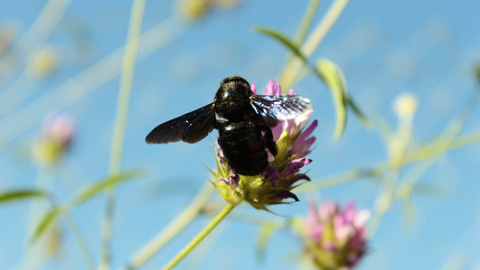Decline in bee population a reality

04/07/2017
Several research studies demonstrate that bees are declining in population and some species are even in danger of becoming extinct. The main causes are urban development, the introduction of new species, climate change and the use of pesticides. This last cause is a factor which has recently been debated. While some NGOs such as Greenpeace demand the prohibition of a specific type of pesticide called neonicotinoids, the organisms in charge of regulating its use consider that not enough studies have been made to take that step.
Ecologists at CREAF and the UAB Jordi Bosch and Anselm Rodrigo affirm that there is enough evidence to demonstrate that neonicotinoids are harmful to bees. They also highlight the scenario bees face when in agricultural fields: a cocktail of products acting simultaneously. “Not only are they being intoxicated with the insecticides. Intensive farming also uses fungicides and other treatments. In fact, products which claim to cause no harm to bees, when combined with other chemical products, do become dangerous", explains Dr Rodrigo.
The Effects of Pesticides Go Beyond the Death of Bees
In a recent study, Jordi Bosch and other researchers from Italy and Poland analysed the effects of low (non-lethal) doses of the fungicide propiconazole and the neonicotinoid pesticide clothianidin. “It is important to analyse doses similar to those found by bees in agricultural fields in order to reach a realistic result of how they are affected by the chemical products. In this case we compared the effects on honey bees (Apis melifera), bumblebees (Bombus terrestris) and a wild bee species (Osmia bicornis)”, says CREAF researcher Jordi Bosch. He goes on to say that, “The results show that with the doses used, the two products were not toxic per se, but when the bee ingested both products, there was a significant mortality rate. of the three species, the most affected is the wild bee”.
But not only is there a need to calculate how many bees die because of the insecticide, there are also many other effects. According to Anselm Rodrigo, “The effects of pesticides in agricultural fields can also lead to disorders such as confusion and changes in conduct. In fumigated fields for example, bees dance less and are less oriented before they leave the hive, and that makes them give less information to other bees about where the flowers are; this causes them to get lost, not return to the hive, or need more time to find flowers, and therefore makes them less productive”. That could explain why many beekeepers are finding their beehives emptier, a phenomenon known as colony collapse disorder.
Honey Bees in Spain: one in a thousand
“A common error is to think that putting these issues on the table means talking only about honey bees. The number of honey beehives has declined in some countries, but when the species is studied globally, there is no need to say that they are in danger of extinction. Wild bees are the ones reducing drastically in number”, Dr Bosch clarifies. He points out an important figure “In Spain specifically, the proportion between wild bees and honey bees is 1000 to 1. Obviously there is a need to study honey bees, but this cannot be done in an isolated manner, because the other species also intervene in the pollination and production of fields, and they are also affected by the insecticides”.
From Local to Large Scale Effects
Harming bees does not end with the death of these insects, the effects are larger in scale. This decline in numbers represents a loss in biodiversity, damage to a key part of many ecosystems and their food networks, as well as a reduction in the pollination of agricultural fields.
We must not forget that neonicotinoids remain in the soil and therefore can reach aquifers or the air, through the dust produced by tractors. The cycle could thus also represent a problem for the health of humans. “The future must include changing intensive farming and monoculture for a more ecological agriculture based on ecosystem services” say both CREAF and UAB researchers.
Original article:
Sgolastra F., Piotr Medrzycki, Bortolotti L., Molowny-Horas Roberto, Bosch J. et al. Synergistic mortality between a neonicotinoid insecticide and an ergosterol-biosynthesis-inhibiting fungicide in three bee species. Pest Management Science 73 (6), 1236-1243. DOI 10.1002/ps.4449